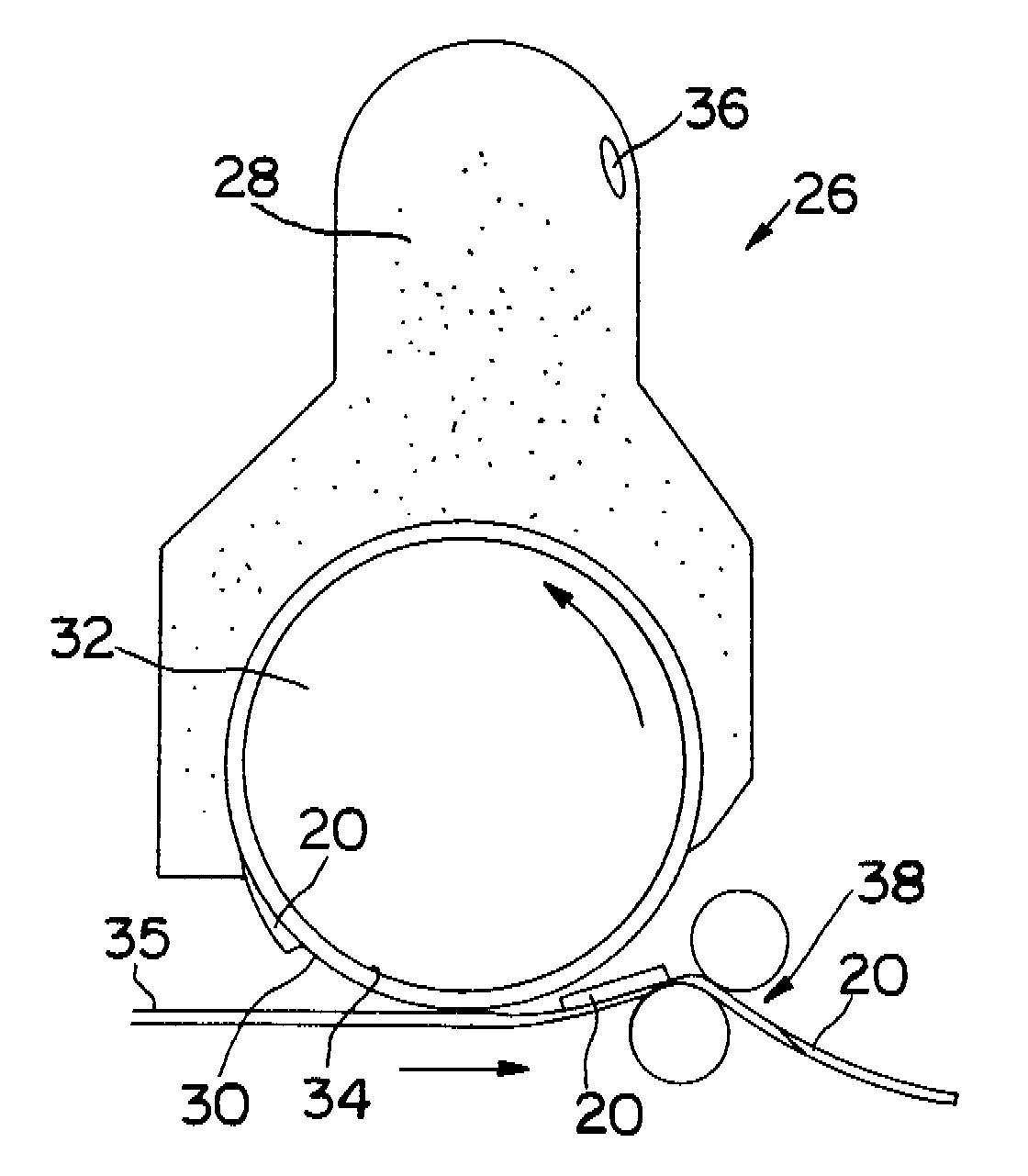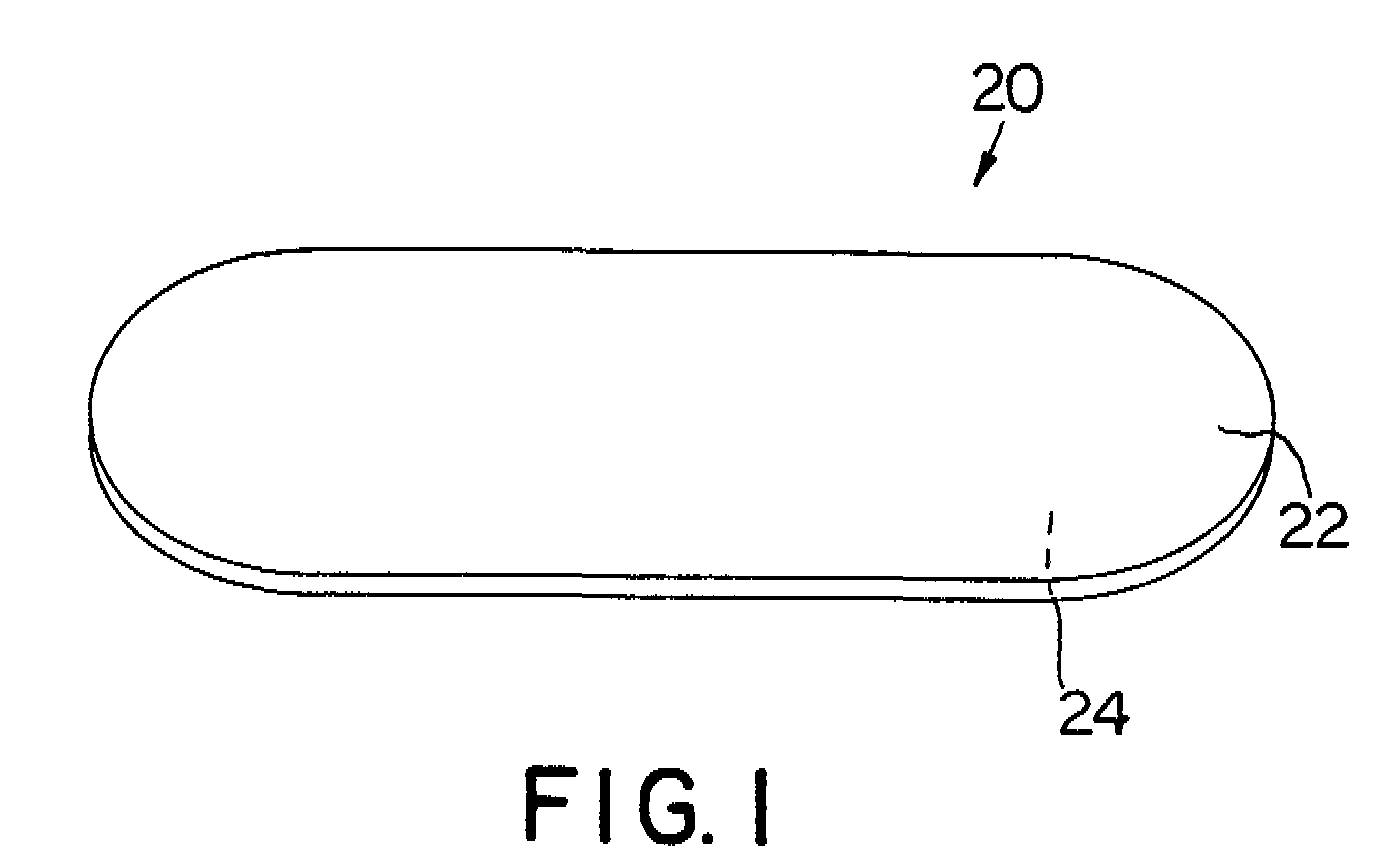Method for producing thin, high capacity absorbent structure
a technology of absorbent pads and absorbent materials, which is applied in the direction of sanitary towels, manufacturing tools, fibreboards, etc., can solve the problems of low absorbent capacity of low density pads, inability to absorb liquids from many high-absorbent materials, and stiffness and lack of uniformity of absorbent materials within pads
- Summary
- Abstract
- Description
- Claims
- Application Information
AI Technical Summary
Benefits of technology
Problems solved by technology
Method used
Image
Examples
example 1
[0074]In this example, eight different sample absorbent pads were produced using the on-line forming drum of a PULL-UPS® Disposable Training Pants production machine. The pads possessed differing compositions and densities, and were tested to determine their absorption time and intake time. The various types of SAP used included a SAP having high gel strength available under the trade designation FAVOR® SXM 9543, available from Stockhausen GmbH & Co. KG, D47805 of Krefeld, Federal Republic of Germany; and a polyacrylate material available from Stockhausen under the trade designation FAVOR® SXM 880. The various types of pulp fluff used included a bleached, highly absorbent sulfate wood pulp available under the trade designation CR1654, available from U.S. Alliance, Childersburg, Alabama, U.S.A.; a bleached southern softwood pulp available under the trade designation NB-4 16, available from Weyerhaeuser Corporation of Federal Way, Wash., U.S.A.; a southern softwood pulp that has been ...
example 2
[0082]In this example, absorbent pads were produced using the online forming drum of a PULL-UPS® Disposable Training Pants production machine. The machine was configured so that absorbent pads could be extracted from the process line just before combining with other components in the product assembly process. This permitted evaluation of the online formed pads without having to disassemble finished product. This trial used rectangular shaped, uniform depth, forming screens with micro-perforated screen openings produced by FT&D located in Helen, Ga. The microperf screens were able to prevent SAP from passing into the interior of the forming drum, similar to a fine mesh fabric wrap. This produced consistent absorbent weights, even at SAP levels exceeding 65%. Airflow uniformity and volume were maintained in the normal operating range and resulted in good pad formation.
[0083]Adding small amounts of moisture to the absorbent was desired as a means of reducing the pressure required to ac...
example 3
[0090]A commercial machine trial was conducted to produce online ultra thin absorbent pads and products containing the online ultra thin absorbent pads. Forming screens 34 with a contour shape, as shown in FIG. 8, were wrapped with a polyester mesh fabric. These forming screens also had a front pocket, a deep zone to allow more absorbent to be positioned in the insult zone of the product. Products were produced with contoured absorbent pads that had about 60% of the absorbent mass in the front half of the pad. Pads and products were produced at commercial line speeds, in excess of 600 feet per minute.
PUM
| Property | Measurement | Unit |
|---|---|---|
| weight percent | aaaaa | aaaaa |
| pressure | aaaaa | aaaaa |
| weight percent | aaaaa | aaaaa |
Abstract
Description
Claims
Application Information
 Login to View More
Login to View More - R&D
- Intellectual Property
- Life Sciences
- Materials
- Tech Scout
- Unparalleled Data Quality
- Higher Quality Content
- 60% Fewer Hallucinations
Browse by: Latest US Patents, China's latest patents, Technical Efficacy Thesaurus, Application Domain, Technology Topic, Popular Technical Reports.
© 2025 PatSnap. All rights reserved.Legal|Privacy policy|Modern Slavery Act Transparency Statement|Sitemap|About US| Contact US: help@patsnap.com



